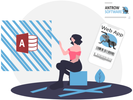
Microsoft SQL Server, commonly known as SQL Server, is a relational database management system developed by Microsoft. The story of SQL Server began in the late 1980s when Microsoft realized that there was a growing demand for a database management system that could run on the Windows platform.
In 1988, Microsoft teamed up with Sybase, a company that had already developed a successful database management system called Sybase SQL Server, to create a version of SQL Server for Windows. The first version of SQL Server was released in 1989, and it was essentially a port of Sybase SQL Server to the Windows platform.
Over the next few years, Microsoft continued to work with Sybase to develop new versions of SQL Server, and the product became increasingly popular among Windows users. However, in the mid-1990s, Microsoft and Sybase parted ways, and Microsoft decided to develop its own version of SQL Server from scratch.
The first version of Microsoft's SQL Server, called SQL Server 6.0, was released in 1995. It was a major step forward for the product, as it included many new features that were not available in the earlier Sybase-based versions. SQL Server 6.0 was also the first version of SQL Server to be fully integrated with Windows, and it included many performance enhancements that made it a faster and more efficient database management system.
In the late 1990s, Microsoft continued to develop SQL Server, and it became a popular choice for large-scale enterprise applications. SQL Server 7.0, released in 1998, included a number of new features that made it easier to use and more scalable, including support for distributed transactions, online backup and restore, and improved query optimization.
In 2000, Microsoft released SQL Server 2000, which included even more new features, such as support for XML and the ability to scale out a database by clustering multiple servers. SQL Server 2005, released in 2005, was a major release that included a new query engine, support for partitioning, and many other improvements.
Subsequent releases of SQL Server have continued to improve the product, with new features such as support for in-memory databases, improved performance and scalability, and enhanced security features. Today, SQL Server is widely used in enterprise applications and is considered to be one of the leading database management systems in the market.